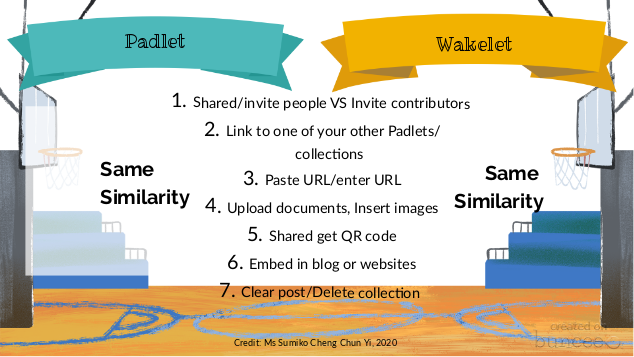Wakelet vs. Padlet: A Comprehensive Comparison Guide 2024

Wakelet vs. Padlet In the digital age, collaborative tools have become indispensable for educators, students, and professionals alike. Among these tools, Wakelet and Padlet stand out as popular platforms for organizing, curating, and sharing information. While they serve similar purposes, each platform has its unique features that cater to different user needs. This article will dive into a friendly comparison of Wakelet vs. Padlet, highlighting their strengths, weaknesses, and ideal use cases. Wakelet vs. Padlet

1. Overview of Wakelet and Padlet
What is Wakelet?
Wakelet vs. Padlet is a versatile content curation platform that allows users to gather and organize multimedia content from various sources into collections called “wakelets.” These collections can include articles, images, videos, notes, PDFs, and more. Originally developed to help users curate online information seamlessly, Wakelet has become a popular tool for collaborative learning and project management. Wakelet vs. Padlet
What is Padlet?
Wakelet vs. Padlet on the other hand, is an interactive online bulletin board that enables users to post content in various formats. From text and links to images and videos, Padlet boards are highly customizable, supporting collaboration in classrooms, brainstorming sessions, and team projects. With an intuitive drag-and-drop interface, Padlet has carved out a niche as a simple yet powerful tool for idea sharing. Wakelet vs. Padlet

2. User Interface and Ease of Use
Wakelet’s Interface
Wakelet vs. Padlet boasts a clean, minimalist interface that prioritizes user-friendliness. The platform emphasizes simplicity in content creation, allowing users to build collections without a steep learning curve. Its design caters to both beginner and experienced users, with an easy-to-navigate dashboard that makes finding and organizing content effortless. Wakelet vs. Padlet
Padlet’s Interface
Wakelet vs. Padlet user interface is dynamic and visually engaging. Its drag-and-drop functionality makes creating boards feel natural and intuitive. Whether arranging posts in a grid, stream, or map format, Padlet adapts to various styles of content display. However, some new users might find the number of customization options overwhelming initially. Wakelet vs. Padlet
Verdict: If simplicity is your priority, Wakelet offers a straightforward experience. For those who prefer more visual customization and flexibility, Padlet is a better choice. Wakelet vs. Padlet
3. Key Features Comparison
Wakelet’s Features
- Collection Creation: Users can compile multimedia content into themed collections, perfect for lessons or research projects.
- Collaboration: Real-time collaboration allows multiple users to contribute to a collection, enhancing teamwork. Wakelet vs. Padlet
- Integration: Wakelet integrates with tools like Microsoft Teams, making it ideal for educational and professional environments.
- Accessibility: The platform supports immersive reader functionality, aiding users with different learning needs. Wakelet vs. Padlet

Padlet’s Features
- Multiple Layouts: Padlet offers various layouts such as grid, wall, canvas, and timeline, catering to different presentation needs. Wakelet vs. Padlet
- Rich Content Types: Users can post notes, photos, links, voice recordings, and more, making it versatile for creative projects. Wakelet vs. Padlet
- Customizability: Backgrounds, themes, and fonts can be tailored, allowing for a personalized experience. Wakelet vs. Padlet
- Privacy Options: Robust privacy settings let users control who can view, edit, or contribute to their boards. Wakelet vs. Padlet
Verdict: Padlet has the edge in terms of creative customization and layout variety, while Wakelet shines with its seamless integration and straightforward collection-building capabilities.
4. Collaboration Capabilities
Collaboration on Wakelet
Wakelet encourages collaborative content curation. Users can share a link to their collection and invite others to add, edit, or comment on the content. This is especially useful for educators who want students to work together on assignments or group projects. Wakelet vs. Padlet
Collaboration on Padlet
Padlet excels in real-time collaboration. Users can see each other’s contributions instantly, making it a powerful tool for brainstorming sessions, interactive discussions, or collaborative storytelling. Participants can leave comments and reactions, fostering a more interactive environment.
Verdict: For projects that require dynamic and immediate interaction, Padlet is superior. However, for curated content creation with an educational focus, Wakelet holds its ground well. Wakelet vs. Padlet
5. Multimedia and Content Curation
Wakelet’s Approach
Wakelet is built around the concept of content curation. Users can gather multimedia from the web or upload their own files, arranging them in a cohesive manner. This makes Wakelet ideal for research compilations, lesson plans, and personal projects.
Padlet’s Approach
Padlet’s bulletin board style enables users to post content spontaneously. While it supports multimedia uploads and embeds, its strength lies in idea sharing and real-time posting. The flexible layout supports creative project management and group brainstorming. Wakelet vs. Padlet
Verdict: Wakelet excels in curated content collections, whereas Padlet is better for spontaneous and collaborative posts.
6. Customization and Layout Options
Wakelet Customization
Wakelet provides basic customization, allowing users to choose cover images and reorder content. It’s designed for those who want a simple, organized approach without overwhelming customization options.
Padlet Customization
Padlet is highly customizable. Users can change backgrounds, adjust font styles, and choose from various layouts such as wall, shelf, and canvas. This flexibility is perfect for those looking to make their projects visually distinctive.
Verdict: Padlet is the clear winner for users who want a more personalized and visually engaging interface.
7. Educational Applications
Using Wakelet in Education
Wakelet has gained popularity in classrooms for creating lesson plans, digital portfolios, and research projects. Teachers can build collections of resources, share them with students, and allow for collaborative curation. Its integration with platforms like Microsoft Teams makes it a convenient choice for schools.
Using Padlet in Education
Padlet’s real-time collaborative features are ideal for interactive learning. Teachers can use it to facilitate discussions, post assignments, or create collaborative timelines. The platform’s visual appeal helps engage students and encourage participation.
Verdict: Both tools have strong educational value, but Wakelet is better suited for structured projects and research, while Padlet enhances interactive learning and participation.
8. Pricing and Accessibility
Wakelet Pricing
Wakelet is completely free to use, which is a major advantage for schools and educators with tight budgets. There are no hidden costs for accessing its main features, making it an attractive option for large groups.
Padlet Pricing
Padlet offers a free version with limited storage, which is sufficient for small projects. For more extensive use, users must subscribe to a paid plan, which provides additional storage and enhanced features.
Verdict: For budget-conscious users, Wakelet is the winner. If you’re willing to pay for more features and customization, Padlet is worth considering.
9. Mobile App and Usability
Wakelet’s Mobile Experience
Wakelet’s mobile app is user-friendly and replicates the web experience effectively. Users can create, edit, and share collections on the go.
Padlet’s Mobile Experience
Padlet’s app maintains the platform’s interactive feel, allowing users to create and edit boards seamlessly. The real-time update feature works smoothly, ensuring collaborative sessions stay uninterrupted.
Verdict: Both platforms offer solid mobile experiences, but Padlet may be more appealing for those who value real-time interactivity.
10. Community and Support
Wakelet Community
Wakelet has a supportive user community, especially among educators. The platform frequently hosts webinars and provides resources to help users maximize its capabilities.
Padlet Community
Padlet also boasts an engaged community, with active forums and a strong online presence. The platform offers tutorials and a robust help center for users who need assistance.
Verdict: Both platforms foster strong user communities, but Wakelet has a more pronounced focus on educational training and support.
11. Pros and Cons Summary
Pros of Wakelet
- Completely free to use
- Great for structured, long-term projects
- Integrates well with Microsoft Teams
- Easy to use and beginner-friendly
Cons of Wakelet
- Limited layout customization
- Not as dynamic for real-time interaction
Pros of Padlet
- Highly customizable with diverse layouts
- Excellent for real-time collaboration
- Engaging and interactive interface
Cons of Padlet
- Paid plans required for full access
- Can be overwhelming for new users
12. Ideal Use Cases
- Wakelet: Best suited for educators, researchers, and professionals looking to curate and present information in a structured format.
- Padlet: Ideal for collaborative brainstorming, team projects, and interactive classroom activities where creativity is key.
13. Verdict: Which One Should You Choose?
Both Wakelet and Padlet are powerful tools in their own right, each offering unique benefits depending on the use case. If you need a tool that’s simple, free, and great for compiling resources, Wakelet is the go-to choice. However, if you want a more customizable platform for collaborative and interactive work, Padlet is worth the investment.
14. Final Thoughts
Choosing between Wakelet and Padlet ultimately depends on your goals. Whether it’s structured content curation or spontaneous idea-sharing, each platform has its strengths. Explore both to see which fits your needs best—you might even find that a combination of the two enhances your productivity and creativity.
FAQs
Q1: Can Wakelet be used without an internet connection? A: No, Wakelet requires an internet connection to access and update collections.
Q2: Is there a storage limit on the free version of Padlet? A: Yes, the free version has storage limits, but the paid plans offer expanded storage options.
Q3: Can Padlet be integrated with other tools? A: Yes, Padlet can be integrated with tools like Google Classroom, making it useful for teachers.
Q4: Are Wakelet collections shareable with people who don’t have an account? A: Yes, you can share Wakelet collections via a public link, allowing anyone to view them.
Q5: Does Padlet support different languages? A: Yes, Padlet supports multiple languages, making it accessible to a global audience.
Q6: Is it possible to embed Wakelet collections in websites? A: Yes, Wakelet collections can be embedded into websites and blogs for broader sharing.




